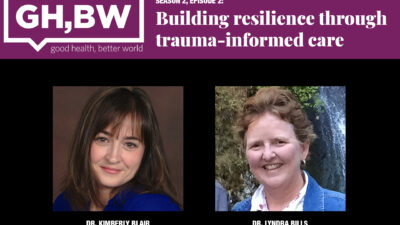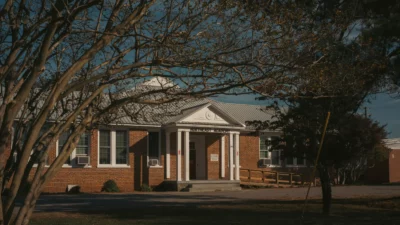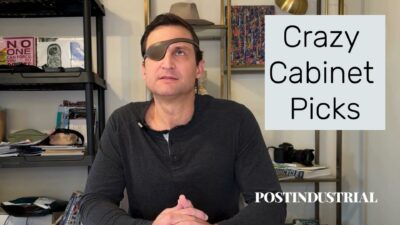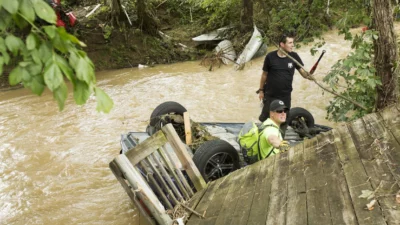In this episode:
In this season’s second episode, our guests talk with host Dr. Ellen Beckjord about ways that trauma and anxiety have affected people as our lives shifted as a result of the pandemic.
Hear from Dr. Kimberly Blair, psychologist at Western Psychiatric Hospital, and Dr. Lyndra Bills, senior medical director at Community Care Behavioral Health Organization.
How can trauma-informed care and trauma-informed systems of care can help to build resilience?
Have questions? Email us at [email protected]
Resources:
Are you experiencing a crisis or are concerned about a loved one?
Residents of Allegheny County can call resolve Crisis Network which provides crisis counseling for a variety of issues, at 1-888-796-8226, or click here.
Learn more about The National Child Traumatic Stress Network, by clicking here.
For help with addiction, call the Substance Abuse and Mental Health Administration's hotline at 1-800-662-4357, or click here.
For help with a mental health crisis, reach National Alliance on Mental Illness by dialing 988, or click here.
To reach UPMC Western Psychiatric Hospital and UPMC Western Behavioral Health, call 1-877-624-4100, or click here.
UPMC Health Plan members can learn more about behavioral health programs, tools, and resources, by clicking here.
To learn more about Community Care Behavioral Health, click here.
More:
What is trauma-informed care? Read this brief from Harvard Health Publishing.
What doctors wish patients knew about trauma-informed care, from the American Medical Association.
Visit the Good Health, Better World podcast page, here, and read the transcript, below:

Dr. Ellen Beckjord: We're going to talk about building resilience through trauma-informed systems of care.
Dr. Ellen Beckjord: I'm very pleased to welcome Dr. Lyndra Bills, senior medical director for Community Care, Behavioral Health Organization, as well as Dr. Kimberly Blair, a psychologist at Western Psychiatric Hospital and associate professor of psychiatry at the University of Pittsburgh.
Welcome to Good Health, Better World, Dr. Blair.
Dr. Kimberly Blair: Thank you.
Dr. Ellen Beckjord: Welcome to Good Health, Better World, Dr. Bills.
Dr. Lyndra Bills: Thank you. And I'm happy to be here.
Dr. Ellen Beckjord: And we're glad to have you. And just to open it up, we know that trauma and anxiety affect our mental health and that both increased during COVID-19. Can you talk about how to tell whether you're experiencing trauma or anxiety and ways these issues can affect daily life?
Dr. Lyndra Bills: Sure. In order for something to be significantly traumatic in terms of a stressor, you certainly have to have an event. You mentioned COVID-19, and, certainly, for many people that has been extremely stressful and, for some people, a traumatic stressor. So that's one thing, having the exposure to a significant event, and there are many different types that we face as a general human populace. And then there's the experiences part, which is how the person responds to what has happened. And not everybody responds in the same way to the same type of event.
So that's also something that varies, and many factors contribute to how an individual responds, especially their past life, you know, experience, like how they grew up and things that they might have experienced growing up, but also their social support. So, there are many types of things that could influence the type of experience or how somebody takes it in.
And then the effect would be whether or not it then is something more significant, or something that would contribute to the person having a hard time with their job or social interactions, things like that.
Dr. Ellen Beckjord: So, do you think it's fair to say that, let's say the same event for two people, that the effect that event has is really mediated through that experience. And that experience gets moderated by lots of individual-level factors, both current when the event is experienced and even in their history.
Dr. Lyndra Bills: Yes, that's a really good way to think about it.
Dr. Ellen Beckjord: And so, when we talk about the effect, could you say a little bit about the range or spectrum or continuum of effects and words that we often use to describe these kinds of effects might be stress or anxiety or depression.
Can you say a little bit about how those are different effects and whether it's useful to think about those effects on a continuum as we seek to understand the ways that people respond to traumatic events?
Dr. Lyndra Bills: I like the way you phrased that question. So, it is, it can be a continuum. So, the types of terms people use — so being really anxious and immediately reacting to an event — so being anxious, worried, feeling your heart race, there's a lot of physical reactions to severe stressors that people have very commonly. Heart racing is one thing, you could be sweating, you could feel very tense. So those are all kinds of immediate reactions.
And then certainly a person can experience a lot of images, can have recurrent thoughts and/or images or sensations of what the experience was about, what it felt like. And those things can pop up very unexpectedly. You might have heard the term “flashback,” or some people have nightmares and it can also be experienced in the body.
But those things start coming up if the person is going to have a more severe impact from the event. And then the more that happens, the term we use for those are “intrusive experiences.”
But the more that goes on, the more likely the person wants to avoid anything that could give them that sensation, or remind them of what happened, or make them feel that way again. And that is where a lot of the impact of traumatic experiences then leads to, you know, other more severe complications with their social functioning and working, and things like that.
Layered on top of that is the possibility also of having depression or severe mood changes. And some people get very angry and are very irritable, and also people do things to try to give themselves relief. Sometimes they might use substances, there's a wide array of the kinds of activities or actions that people take to get the relief that they really want.
Dr. Ellen Beckjord: There's some evidence that anxiety and even experiences of trauma increased during the COVID 19 pandemic.
Dr. Blair, Can you talk about how to tell whether you're experiencing trauma or anxiety and the ways these issues can affect daily life? And given your practice focused on pediatrics, adolescents, happy to hear your thoughts on that population in particular.
Dr. Kimberly Blair: So, what we see happening with COVID and the pandemic is those children, adults, families that were already experiencing some predisposition to anxiety or depression, already having real challenges with mental health, those issues tended to become more significant. And then, you see folks who may not have shown any sort of issues will then really come out with some anxiety and issues.
And what we're finding — I run a clinic that serves children and adolescents and their families who have experienced trauma — and this is an issue system-wide, nationwide, probably globally — is that there are a lot of folks coming in to seek out treatment and the mental health system isn't ready to receive the volume.
You know, if you are feeling that level of what we call arousal, which is you're looking for danger and you're sort of used to living in that soup of just like things happening and the media talking about how many deaths are happening, all those things you're just stewing in for what's been years and that sort of sort of ramping up that what we call baseline of anxiety.
And the higher that anxiety gets, the more it's going to impact pretty much most of your functioning.
One other impact that we in particular are seeing is that for children and adolescents who were home for a really extended period of time, school and, you know, community programs, those tend to be sort of the safe havens for kids who have a lot of bad stuff happening in their world. And what has happened is that they didn't have those people watching them and making those reports.
So, what we're now finding is this uptick in children who've experienced a lot of abuse, neglect, those kinds of things, too. So, the impact of the pandemic really is covering every part of the spectrum.
Dr. Ellen Beckjord: Dr. Blair, you characterized the COVID pandemic in a way that I thought was very interesting, was that it exposed the population and certainly children and adolescents to kind of constant stream of information or communication about illness and death and dying.
And so, I'm curious if over the course of your career, if you think that population-level exposure to trauma, particularly for children and adolescents, was increasing even before the COVID pandemic?
I'm thinking about things like gun violence and mass shootings terribly often at schools. I'm thinking about the climate crisis and what kids are learning about with respect to the way our world is changing and ways that that can be really scary.
So, and not that any of those problems are new, but it seems like on all fronts the sort of velocity or intensity of them has increased. Have you noticed changes in that over the course of your career and any tangible effects that you would say on either the folks who come to see you for help or ways that people who are exposed to trauma at an individual level are then doubly affected?
Dr. Kimberly Blair: So, there's a huge continuum, right? We will see kids who, you know, have had all the breaks and really have been isolated to a certain degree by just the advantages that they've that they inherently have who, they may not get exposed to community violence, but certainly school violence. That has certainly been something that we've that we've watched and paid attention to before this this happened.
And if I were to pick out sort of a common theme looking across all of those children and all of those families, and this is just my experience as a clinician, I think that one of those things that is those feelings that kids and families may have is sort of that lack of control.
So, you have this pandemic or you have school violence on kids who just (were) sort of exposed to it in the media, to kids who've experienced it firsthand. And the common theme there being control is, you know, if we're going to, we want to try and empower kids to feel like they have some sort of control. So, if you are able to provide specific ways to them that they can then take some sort of piece of control of their world that will sometimes help sort of reduce some of those feelings of anxiety.
And safety is one of those things that is sort of the first thing on the list when you're seeing a kid in treatment to work on their feeling of their sense of safety and their feeling of control and how they can. They can help make themselves safe. So, I think we can apply that to really all of those systemic stressors.
And I think it's going to be different for different kids and what makes them feel better.
Dr. Ellen Beckjord: Can we talk for a moment about avoidance? And I'd like to talk about it as a segue into thinking about and discussing trauma-informed care. So, you're a psychiatrist and an internist by training. I'm a clinical psychologist by training. And I've often thought that avoidance is a really core construct that shows up in lots of psychopathology or lots of mental health or behavioral health challenges.
What are the ways that health care delivery in the experience of receiving health care can challenge a person's intentions to avoid things that might trigger or remind them of a trauma.
Dr. Lyndra Bills: Well, it's a really good thing you're kind of honing in on avoidance, because I would agree. I think that's one of the most significant challenges for the helpers, the clinicians, or in the health care area, if you are trying to provide some assistance to somebody who's had the impact of a significant traumatic stress.
So, their skillset in avoiding or being tuned in to any kind of environmental cue or reaction from somebody that might touch on that, for them, what was a horrible experience is so important.
I think health care providers and environments of health care need to be sensitive to how easy it is for some somebody to be affected by the environment in a sense, like in every possible way, from the minute you walk through the door, how somebody greets you, the way in which they greet you is the environment of care. You know, does it feel comfortable? Does it feel safe? Those are a lot of things that health care settings can address and make better.
Dr. Ellen Beckjord: And then once they've got to engage with the system of care, it can raise issues that they may have been able to successfully avoid, so much so that it's really outside of their awareness.
Dr. Lyndra Bills: Right. So, it can make it so difficult for them to get even basic usual care, preventive care, especially if you, you know, have somebody who's experienced difficulties in the care setting, or they might have been traumatized. Some people are traumatized by medical care. And, so, the most important thing for care providers is being thoughtful, to want to understand people's experiences.
Dr. Ellen Beckjord: Dr. Blair, I would love to hear your perspective on trauma-informed care, the importance of trauma-informed care, particularly for children and adolescents. And then as we discuss this, I'd love to hear your perspective on how trauma-informed care functions when you're intervening with a family.
Dr. Kimberly Blair: So, talking about trauma-informed systems, when we're talking about children and families, you know, one of the primary systems that they deal with throughout childhood is the school systems. Right?
So that education system is, those kids that you see that have armor on. That if you are constantly protecting yourself, looking for danger, those kinds of things, it doesn't leave a lot of extra bandwidth for them to focus on their letters and numbers and reading and science. And so, they're missing a lot of those things. And so, you do have to go in and sort of look at each I think each system and see what the needs are in each.
I think that with COVID, you have this sort of awareness that like really most kids right now have had exposure to some sort of trauma. And it has affected them in individual ways.
Some kids have had family members pass away, and some kids it's just a matter of, that constant exposure to death and sickness and that sort of staying with them. And I think a lot of those issues for kids, we're going to see in the short term. But also, what we're going to see long term for some of these is ….. if we were able to eradicate that illness and no one got sick anymore, we still have all of this time with all of this exposure to this stuff that's really going to stick with us.
I think on a national level, there at least some of the advocacy groups, some of the professional organizations are really paying attention to trauma and how it affects kids in the classroom and how we have this sometimes-competing agenda for trying to meet our educational goals for kids, to give them those skills that they're going to need to be successful.
At the same time, dealing with all the stuff in that kid's world, coming into the classroom. And we're not certainly not where we need to be with regards to that. But there are there's funding that's starting to go to schools, some of it as a result of COVID and the pandemic. But it's that focus on trauma and the understanding that our kids are not just sort of empty vessels in the classroom for us to sort of put all this educational knowledge in…I think that most education systems recognize that there's more work to do. And so, we really are beginning to, I think, focus more than we had before. But it had started prior to COVID. COVID just, I think, made things a little bit more urgent.
Dr. Ellen Beckjord: Dr. Bills, what are some of the ways that providers can take a systematic and evidence-based approach to assessing trauma history so that they can be informed in their efforts to deliver trauma-informed care?
Dr. Lyndra Bills: Well, it is really important for all health care systems or places you get health care to certainly try to be trauma-informed and thoughtful, which would mean that you would want to do some type of screening, or at least start with history taking. So, for instance, things like using the Adverse Childhood Experiences Survey — a lot of health care settings use that ten-item question to get a history of a person's early adversity or experiences that could have made it difficult for them ongoing or predispose them to have problems with other stressors. So, that's something they could do. And, also, there are many clinical screening tools that are available and widely accepted, and every healthcare setting should take a look at those available tools and kind of decide what would fit in terms of their process.
Dr. Ellen Beckjord: And so, Dr. Blair, you're really a specialist in the mental health field and your specialty is trauma. What's your take on how well the healthcare system is doing at delivering trauma-informed health care? And is it not uncommon for kids in adolescence to present with physical symptoms that are really related to an underlying traumatic experience?
Dr. Kimberly Blair: So, I think we've known for a long time that those physical symptoms come along with anxiety. And certainly, you know, when we're talking about anxiety as a result of trauma, we see those as well. And, you know, with regards to my specialty, it is trauma.
I came into the mental health field as an early childhood mental health specialist before early childhood mental health was like a thing. And so, what I noticed over years of practice was that we were doing a pretty good job of addressing behaviors and including things like, you know, somatic complaints, those physical health symptoms that go along with it, that everyone's experienced that tummyache. You know, when you're anxious. But, you know, we it became very clear to me that we were missing a piece because we were addressing behaviors, but we weren't necessarily diving deep into those events that happen that sort of cause some of those or led us to some of those behaviors. And so, it evolved from there because we went back and then we started providing specific trauma treatment for young children.
And we have grown from there. And I think that that's relevant in that when you're looking at the mental health system and the physical health system, not all needs are the same.
And so one of the things that we recognize is that our specialty, quote unquote, really is for kids who've had many complicated sort of life-altering stressors and maybe over a long period of time, we call that complex trauma.
But at this point, systemically, you have kids who experience different levels of trauma in every context and every level of care for mental health and in integrated care, in physical pediatrics practices, do their screenings for anxiety and depression and those kinds of things. And you're seeing it everywhere. So, one of the things that we've attempted to do is get information out to all of those different systems.
What we're trying to do is get that information out there from a very basic level that's applicable to everyone. But then going back and talking to the integrated care clinics about what they're seeing and helping them to sort of craft some processes and procedures if they need additional to be able to deal with the kids that they're coming into their doors every day. And it's not a one size fits all type of setting.
Dr. Ellen Beckjord: Dr. Bills, it seems like there are ways that trauma-informed care can help to reduce barriers to receipt of good health care among people who have a trauma history, because trauma-informed care will be sensitive to, and accommodating of their needs. Is it also true that trauma-informed care has value, because recovery from trauma has any number of physical and mental health benefits in its own right?
Dr. Lyndra Bills: It's definitely worth noting, but certainly ongoing stress and chronic stress, chronic traumatic stress can lead to a number of health problems and challenges that can really be difficult for folks. So, it is true that building resilience, which is possible, some people are naturally more resilient or they have those skills, but you can always learn skills to become more resilient.
And that's important for people to know, because it’s sort of building up your muscle to handle the impact of stressors.
Dr. Ellen Beckjord: Resilience-building is important. I'm glad that you mentioned that. A history of one or more traumatic experiences is not determinant of some future state, that treatment is available, recovery is possible, resilience is achievable for lots of people.
Would you also comment on what might even lie beyond that with respect to post-traumatic growth and what some of the circumstances are under which people cannot only recover from trauma, but can use that experience as a way to achieve personal growth and really thrive in ways that are facilitated by their recovery from the traumatic event.
Dr. Lyndra Bills: So, I'm going to go back a little bit to what I was mentioning earlier, related to a trauma-informed approach.
So, I mentioned safety and emotion management. I think about post-traumatic growth as a transformative phase, basically.
When people are able, they're interested, they are ready to take a look at those specific traumatic events or any —whether it's one or more than one — using evidence-based practices, which you mentioned, going through that process helps develop their ability to transform those experiences and really learn from those experiences. And that's, to me, what post-traumatic growth is all about.
I've certainly treated a number of people, and I would say it doesn't ever totally go away, but the ability for a person to not have to have their every moment of every day driven by what happened to them is they're able to move past that — and that's a big deal.
Dr. Ellen Beckjord: Do you think that we talk enough about resilience and hope and recovery in our bigger conversation about trauma?
Dr. Lyndra Bills: Well, the simple answer I have is, no, I think we could do a lot better to talk about that. You know, it's not to diminish the impact of really very horrible experiences for some people and certainly the ongoing, very significant stressors in our world, but I do think, you know, as a health provider, it's my job to instill hope. It's my job to provide options and to brainstorm with somebody to help them find healing. And I do think that there are so many different ways that somebody can do that.
Dr. Ellen Beckjord: Dr. Blair, what does recovery from trauma look like in children and adolescents? One of the themes that seems to be emerging in the conversations that we're having this season on Good Health, Better World about behavioral health is that people recover from behavioral health and mental health challenges. Given your role as a direct care provider, what does recovery look like in children and adolescents who've experienced trauma?
Dr. Kimberly Blair: I think that, you know, your ultimate goal is for children to be able to function in their world in a prosocial way and for them to be happy.
And it sounds very simplistic, but I have so many parents come in and tell me ‘I just want to have a happy, healthy kid.' And that's your ultimate goal.
Now that can mean a lot of things to a lot of people. And that's not to say, once you work with a child to create their trauma story, it's important to pay attention to that trauma and explain that trauma and process that trauma in a way that child is going to understand.
So, you know, the saying is sunshine is the best disinfectant. I think applies here by not talking about it. You're not addressing it. So, when we do address it, that's not to say that those experiences just don't go away.
They're in there. They're going to stay there. And it's not unusual for us to see a kid when they're younger and have the parents call us a few years later and say, you know, my child hit adolescence. They're understanding in a different way what happened to them. And so, you sometimes have to reprocess things over time.
And so, when you're looking at outcomes, you want to see them be able to interact with their world in a constructive, appropriate, healthy way.
Dr. Ellen Beckjord: One question Dr. Bills, if you could enact one change or push for one policy, what would it be to really have a transformational effect on either the availability of or the reliable receipt of trauma-informed care?
Dr. Lyndra Bills: That's also a really great question, and one thing is, it's tough. But I'll tell you what comes up every time I think about this, I would say real screening. If I'm thinking about the healthcare system, I'm going to say screening and meaningful screening. So, if I was just going to pick one thing, I'd have to say screening for the impact of traumatic stress.
And I think all that all the processes that have to go into place to make it done, you know, as best it can be done for the person to have a good experience and to for it to be meaningful, it requires really a system-level shift. A lot of thought has to be put into what happens if the screen is positive? What do we do?
Dr. Ellen Beckjord: Dr. Blair, I am wondering if, as you survey the landscape and think about things that you may feel hopeful or excited about in the field of trauma-informed care, pediatric and adolescent mental health, where are the most important leverage points?
Is there a place or an intervention or a policy or a part of the system where you think, if we really doubled down here, there would be pretty transformational returns?
Dr. Kimberly Blair: So, it's actually something I've thought about quite a bit. And I feel I have to mention that, I feel very fortunate to work for UPMC and Western Psych. And I found that outside-of-the-box thinking is really important. And quite honestly, over my goodness, 17 years there I've felt that ability to sort of try different approaches and different ways to deliver care to children and families. I think that we've got a lot of good folks out there doing some really good care.
I think they can also always use more training and support.
One of those things that sort of drove me early on was not wanting the clinicians who worked for me with me to feel like they didn't know what to do. So, you know, seeking out additional supports, like joining The National Child Traumatic Stress Network, was a way to get them that additional training in those interventions that are effective.
But going back to academics, we just don't have enough people. I really wish that we would look at this immense the mental health shortage in a similar way to we looked at teacher shortages in the past and really invest a lot of support and large-scale funding to help encourage students you know undergrads to go on to get those degrees.
And I and I think that I would just if I if I could have my wish list and what I would really like to see I would like to see a big investment in higher education and training and the encouragement of, you know, undergraduates and those who just starting their undergraduate careers to consider mental health professions.
Dr. Ellen Beckjord: That's a great idea and such an important leverage point within the broader system. Dr. Blair, I want to thank you so much for spending time with us on Good Health, Better World. It was wonderful to hear your perspective, particularly as it relates to children and adolescents in the context of trauma-informed care.
Dr. Kimberly Blair: Thank you for having me.
Dr. Ellen Beckjord: Dr. Bills I want to thank you so much for joining us.
Dr. Lyndra Bills: You’re welcome, I’ve enjoyed it.







